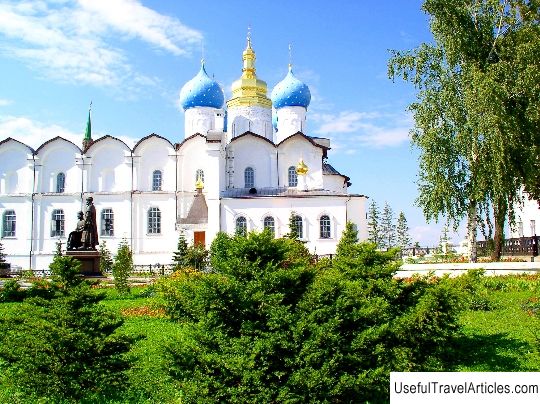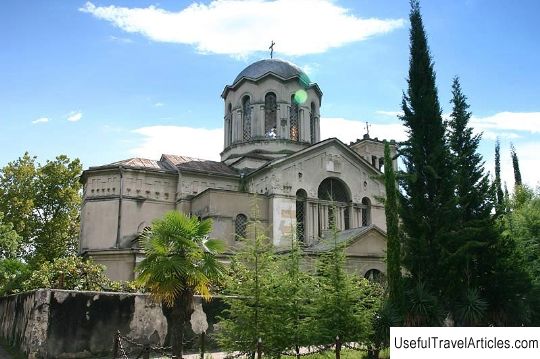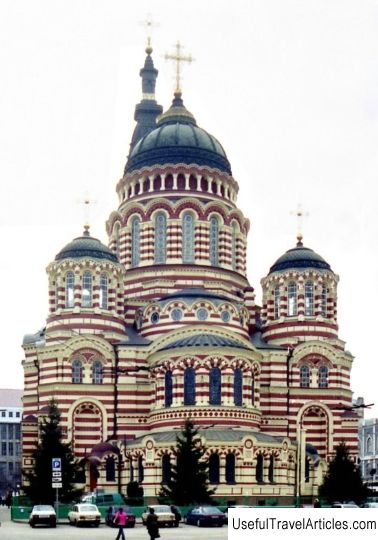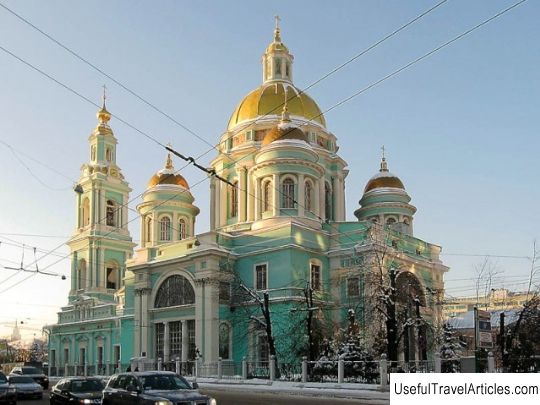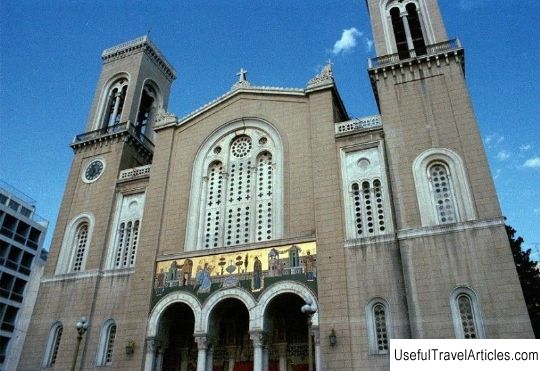Kremlin Cathedral of the Annunciation description and photos - Russia - Moscow: Moscow
Rating: 7,5/10 (100 votes) 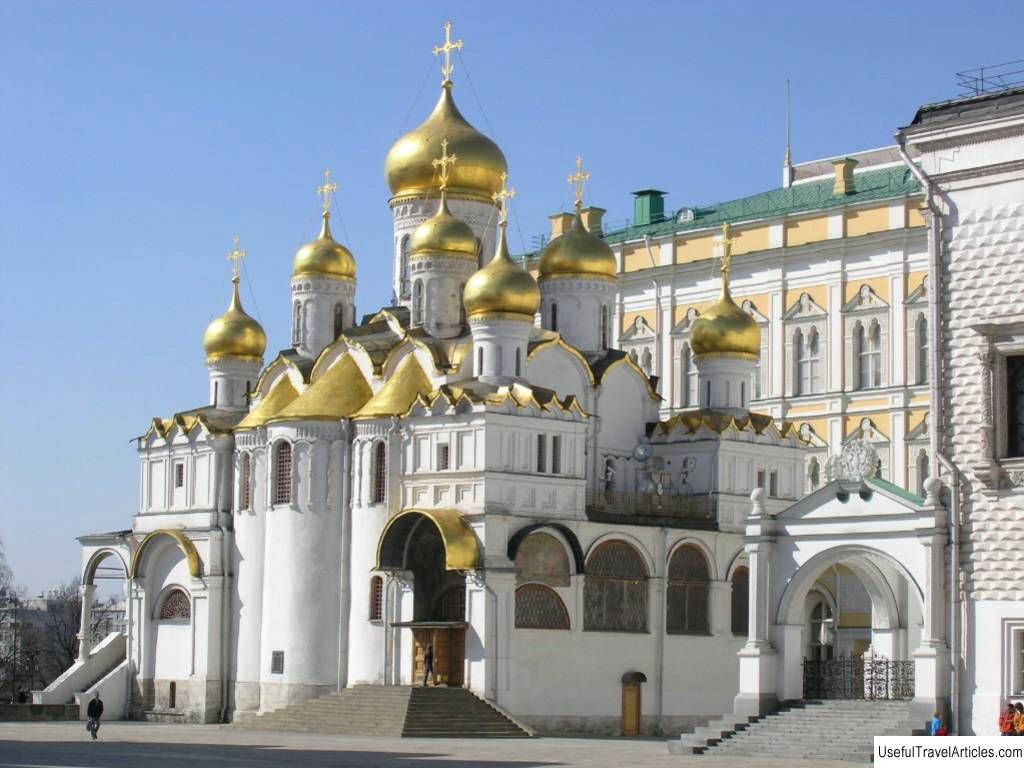
Kremlin Cathedral of the Annunciation description and photos - Russia - Moscow: Moscow. Detailed information about the attraction. Description, photos and a map showing the nearest significant objects. Photo and descriptionThe Annunciation of the Most Holy Theotokos is one of the most solemn and revered holidays among Christians. In honor of the gospel event that occurred with the Virgin Mary , many churches around the world have been consecrated. On Cathedral Square of the Moscow Kremlin one of the most famous and richest churches of the Annunciation rises. Appearing as the home church of a grand-ducal family, the Annunciation Cathedral has become one of the most significant Russian churches, where many great dukes and Russian emperors were crowned and baptized. History of the construction of the Annunciation CathedralIts history is a temple dates back to the XIII century , when a wooden church appeared on the site of today's Annunciation Cathedral. It was erected by order of the Vladimir prince Andrei Gorodetsky , the son of Alexander Nevsky and a member of military campaigns against the Golden Horde khans. A century later, the first stone temple was built on the site of the wooden one. It was a house church with one head, built of stone blocks. The basement of the first white-stone church was preserved and was later used in the construction of the cathedral. The early stone church was decorated with wall paintings, which in 1405 were made by the famous Russian masters Andrei Rublev, Theophan the Greek and Prokhor s Gorodets . Frescoes also adorned the altar barrier. It contained images of the saints. The first stone cathedral was called the "Annunciation on the royal entrance". In 1416, the Church of the Annunciation at the Grand Ducal Sovereign's court was dismantled and it was decided to build a new one. The previous building did not meet modern requirements and was too cramped and inconspicuous for the tsarist scale. As a result, the temple received a large central and two small domes, and as decoration - a carving on a drum and an apse. So it became similar to the Church of the Nativity of the Virgin on Senyi , partially preserved to this day. The first Moscow Tsar Ivan III in 1484 decides to rebuild the house church ... Famous artisans Kryvtsov and Myshkin are ordered from Pskov to carry out the work, and five years later the architects will report on the completion of the work. The new church was surrounded by a porch, in the basement, which has been preserved from the former times, the royal treasury was kept, and in the decor of the facades one could guess the features of various schools of ancient Russian architecture: both Suzdal and Vladimir, and Moscow and Kostroma. The white stone pillars supporting the covered galleries were decorated with rosettes in the form of flowers, and the porches themselves connected the temple with the Treasury and the royal palace . At the beginning of the 16th century, the new church was painted, and frescoes with images of Aristotle and Socrates, Plato and Ptolemy appeared on its walls. The icons in the temple received precious salaries. Unfortunately, fires were in that era one of the main disasters that people almost could not resist. Not saved from the fire and the Annunciation Church. It was badly damaged in 1547 when the fire element destroyed not only icons and books, but also frescoes, stone carvings and part of open galleries. From Ivan the Terrible to the present dayAlexander Nevsky and received a new Empire style iconostasis. A little later, a sacristy was added to the southwestern part of the temple, and an arcade adorned the southern porch. In honor of the emperor Nicholas I in 1836, the chapel of St. Nicholas the Wonderworker appeared in the cathedral, and then the temple was connected to the Grand Kremlin Palace, built for the emperor.In October 1917, during an artillery shelling a shell hit the cathedral , causing minor damage. The artist Igor Grabar , who created a committee for the preservation of monuments of ancient painting, convinced the government of the need for a restoration group. In the cathedral, several ancient icons and frescoes were cleared, which, according to researchers, were painted by Theophanes the Greek and Andrei Rublev . The restorers managed to restore the southern portal of the cathedral. In 1955, a museum was opened in the Annunciation Cathedral of the Moscow Kremlin, but restoration work continued until 2010. When the walls were cleaned in the middle of the last century, 16th century frescoes were discovered under the layers of later inscriptions. In 1989, an exhibition was opened in the Annunciation Cathedral, in which they collected icons that belonged to the temple throughout its existence. What to see in the Annunciation Cathedral The architectural appearance of the temple was finally formed in the 60s of the 16th century: - Italian masters of stone carving worked on the portals of the northern and western facades . Both pairs of doors are framed by columns of the Corinthian order, and on the north you can see the Gospel scenes of the prophecies of the Savior and the Mother of God, depicted in a rare technique of fire gilding on sheets of copper. - South portal created in the best traditions of the architects of the early Moscow period. The doors are decorated with half-columns, beads and capitals in the form of sheaves, and the panels are decorated with carved compositions depicting floral ornaments and vases. - The iconographic plot of the "Tree of Jesse" can be seen on the arches of the western and north galleries of the cathedral. It is an allegorical depiction of the Savior's genealogy and consists of more than two hundred figures. At the entrance, Tsar David is depicted first, and on the western portal you can see the Mother of God with the baby Jesus in her arms, completing the tree. - The pillars of the temple are decorated with images of the great Moscow and Russian princes - Vladimir Monomakh , Vladimir Krasnoe Solnyshko, Ivan Kalita, Dmitry Donskoy and Alexander Nevsky. - The South Gallery of the temple serves as a place where a collection of icons that have been in the temple since the XIV century is collected. One of the most valuable and ancient, according to legend, was written by the Evangelist Luke. The Smolensk Icon of the Mother of God, called the Odigitria , is especially revered in Orthodoxy. Its celebration takes place on August 10 and is considered that the image protects the western borders of Russia. In the 15th century, the relics of many saints were sent from Greece as a gift, which were placed in a silver shrine and kept in the southern gallery of the Annunciation Cathedral. The iconostasis of the temple The altar partition separating the altar from the rest of the Orthodox church and located between the southern and northern walls, is called the iconostasis. In the Annunciation Cathedral of the Moscow Kremlin, the iconostasis is high and it is the oldest among such iconostases in Russia. The frame of the iconostasis is made of bronze by the method of chasing . The project was drawn by Nikolai Sultanov , a Russian architect and art critic. Sultanov explored the Byzantine style, and his most famous architectural project was the Peter and Paul Cathedral in Peterhof. Nikolai Sultanov restored many estates and churches throughout the country and, in particular, supervised the restoration of the Volkov-Yusupov chambers in the Kharitonevsky lane of the capital. The iconostasis of the Annunciation Cathedral consists of five rows , called ranks ... The festive and deesis rows were painted in the XIV-XV centuries. Some researchers believe that this was done by Rublev and the Greek, but other art critics and historians question this hypothesis. The Deesis tier of the high iconostasis in the Kremlin Cathedral consists of eleven icons, each of which is 210 cm high. The festive row contains fourteen altar images. The most ancient icon of the altar partition of the Annunciation Cathedral is All-Merciful Savior . It can be seen to the right of the Royal Doors. The other two ranks contain images written later, in the 16th century. Thirty tablets of the iconostasis depict the Menaion of each month of the year, holidays and some saints, as well as important biblical subjects, including the Presentation of the Lord, Adoration of the Magi, Baptism and Transfiguration of the Lord. Exposition "Treasures of the Moscow Kremlin" Many interesting historical relics are kept in the basement of the church, where the exhibition “Treasures of Moscow Kremlin ". The collection includes jewelry, church utensils, ingots of precious metals, coins and weapons. In total, the museum has more than one and a half thousand exhibits, and they are all dated to the historical period from the 12th to the 17th century. More than two hundred rarities from the section dedicated to ancient jewelry art were found in Moscow treasures at the end of the last century. They were buried in the first half of the 13th century, when Moscow was threatened with ruin by the hordes of Khan Batu. In the collection you can see ornaments for the head and hands, parts of a ceremonial costume, filigree beads-agraphs, bracelets, gilded medallions and pendants for headdresses . Silver bars , exhibited in the museum of the Annunciation Cathedral, served both as a means of payment and investment. Each ingot from the found treasures weighs about 200 grams. In the XIV century, two good horses could be bought for it. Shishaki helmets , which were forged from a single iron plate, served the Russian horsemen. In the museum you can see in detail the original helmets of the 15th century, as well as weapons - battle ax, iron arrowheads, chain mail and plate .      We also recommend reading Al-Aqsa Mosque description and photos - Israel: Jerusalem Topic: Kremlin Cathedral of the Annunciation description and photos - Russia - Moscow: Moscow. |
